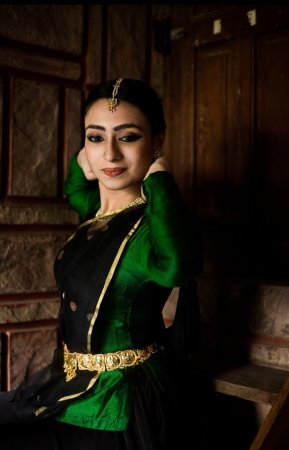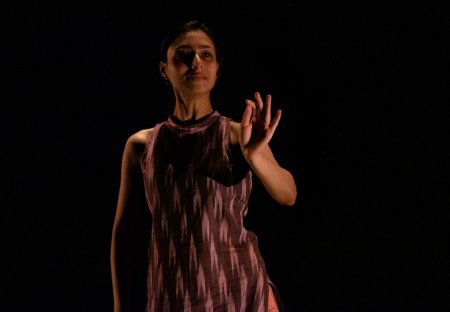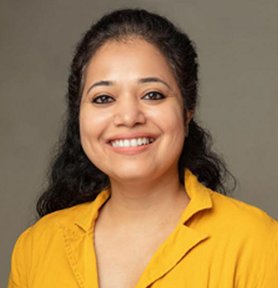 |
  |
 |
  |
Shivani Jatar reimagines Kathak through a Contemporary lens - Kasmin Fernandes e-mail: kasminatwork@gmail.com October 3, 2024 This boundary-pushing Kathak dancer and choreographer blends tradition with contemporary themes, creating a feminist and cross-cultural reimagining of the classical art form. From the rhythmic footwork of traditional Kathak to the experimental choreographies she now performs in Leeds, UK, Mumbai-born Shivani Jatar's journey is one of balancing tradition and innovation. Steeped in the age-old techniques of Kathak, yet pushing its boundaries, this young dancer offers a fresh perspective on the classical Indian dance form. Shivani's technical mastery of Kathak is evident in her attention to tatkar which serves as the foundation of her performances. Wearing ghungroos, she skilfully weaves intricate rhythmic patterns known as tihai into her movements, creating a dynamic interplay between sound and motion.  Shivani Jatar "I like to describe Kathak without relying on the stereotypical definitions and by employing a decolonised vocabulary. I take efforts to describe it as an artistic practice, not just as a cultural or traditional dance style," she says from Leeds. Trained under accomplished gurus like Rupali Desai and Sanjukta Wagh, she laid the foundations of her art in India, only to broaden the scope of her craft through interdisciplinary and international influences. Her work challenges the preconceptions of Kathak as a static, traditional dance form, positioning it as a dynamic art practice that engages with contemporary themes, feminism, and cross-cultural dialogue. Shivani's journey with Kathak began early, at the age of five. Like many young dancers, she was introduced to the form through traditional schooling in Mumbai. However, her fascination with Kathak wasn't limited to its surface beauty. For her, the rhythms, the spins, and the storytelling capabilities of the dance held deeper meanings. She recalls, "It has been a long and joyous journey with dance." That joy eventually transformed into a personal engagement with the form. Reflecting on her formative training, Shivani says, "Rupali Tai's training gave me a strong foundation in the classical aspects of Kathak—precision, discipline, and respect for tradition. Sanjukta Didi, on the other hand, encouraged me to push boundaries and explore Kathak as a means of contemporary expression." These dual influences helped Shivani not just master the dance form but also find ways to incorporate modern themes, improvisation, and collaborative work across art forms. This blending of tradition and innovation became the hallmark of her work as a choreographer and performer. Kathak beyond borders In pursuit of expanding her understanding of dance, Shivani took her passion overseas. Moving to the UK in 2020 to study at the Northern School of Contemporary Dance, she found herself at an intersection of cultures. This move was not just about geographical relocation, but also a transition in artistic language. While Kathak is deeply embedded in Indian culture, she realised that conveying its essence to international audiences required more than just translation—it needed a reinterpretation. Her production One Dha at a Time, staged at Seven Arts in Leeds last year, represents this journey of translating Kathak for international audiences. The piece features four dancers from various backgrounds—each responding to the question, "What truly matters in your practice?" By blending Odissi, Manipuri, and Bharatanatyam alongside Kathak, the production creates a dialogue among these Indian classical forms, showing how they resonate in different bodies and across continents. "I use Hindi terminology because the language itself plays a role in how we engage with and embody the dance," she says. This approach allows her to connect with diverse audiences, helping them see the universal language of movement that exists across cultures. Shivani's fascination with rhythm and her drive to push boundaries is evident in this project. "Each dancer delved into their respective art forms to seek what truly matters in their practice," she explains. This exploration of rhythm is not just technical, it's philosophical. By allowing each dancer to bring their own cultural and artistic experiences into the production, she elevates Kathak beyond its traditional definitions, making it a vehicle for contemporary, intercultural expression. A feminist gaze Central to Shivani's work is a feminist perspective, one that invites critical engagement with the narratives embedded in classical dance forms. "I practise a traditional dance form, but I am not a traditional dancer," she states. Her desire to tell stories that resonate with her lived experiences, as opposed to the conventional stories often told through Kathak, has shaped her artistic journey. Growing up in the 2000s in Mumbai, far removed from Kathak's original Mughal courts and temple settings, she often felt disconnected from the traditional themes she was taught. The more she performed, the more she realised that the stories and cultural symbols in Kathak did not align with her own experiences. This dissonance pushed her to rethink the form itself. "The possibilities of what one could do with Kathak were endless when seen as an artistic practice rather than a cultural one," she says. A feminist lens allows Shivani to see Kathak not as a relic of the past but as a living, breathing art form capable of addressing modern concerns. In her work, she navigates themes of gender, identity, and social justice, continually asking, "What is my Kathak?" Her piece The Contemporary Confusion of the Millennial Kathak Dancer explores this very question. Part of her MA dissertation, the work is an autobiographical research project that examines the tension between tradition and modernity. "The 'confusion' is for me, the performer, to locate my practice of Kathak in the vast landscape of dance with diverse voices across the globe," she says while explaining the title. This confusion, she believes, resonates with millennials and Gen Zers who are constantly navigating the balance between cultural heritage and modern identities.  Shivani Jatar (NSCD and Ely Wel Photography) Cross-disciplinary engagement Shivani's work is not confined to the stage. Her involvement in various residencies and mentorships underscores her dedication to growing both as a dancer and a choreographer. The 'Develop Your Creative Practice' grant from Arts Council England, for example, has allowed her to deepen her choreographic inquiry. Mentored by director John Britton and contemporary dance artist Sade Alleyne, Shivani is now focusing on understanding presence, collaboration, and emotional authenticity in her work. "I have emerged from these experiences with exceptional insights, renewed confidence, and a sense of purpose," she says. In 2021, she further expanded her expertise by completing the Indian Performing Arts Management Course under the tutelage of Masoom Parmar. By understanding the intricacies of arts management—ranging from organising performances and events to marketing and audience development—Shivani has enhanced her ability to navigate the complex and competitive landscape of global arts. Her residency at Open Source Arts in the UK also allowed her to develop Namesake, a project exploring the intersections of identity and movement. In 2023, Shivani completed Abhyas Somatics with renowned dancer and choreographer Navtej Johar. Somatics aligns closely with her desire to integrate her lived experiences into her art, as it encourages performers to create from a place of self-awareness and emotional authenticity. Using art for social advocacy In addition to her dance projects, Shivani is using her platform for social advocacy. She will feature in the November event #ChronicallyMe at the ESRC Festival of Social Science in Leeds. Led by Dr. Lucy Prodgers, this event explores how sharing personal stories about chronic illness on social media can foster connections and empower those living with long-term health conditions. By incorporating dance-poetry performances and interactive activities, #ChronicallyMe seeks to amplify the voices of those navigating chronic illness, demonstrating how art can be a powerful tool for social change. Looking ahead, this Gen Z dancer is optimistic about the future of Kathak. "I believe that Kathak will outlive all of us like it has its earlier practitioners," she says. For her, the form is a living tradition, continually evolving to meet the needs of the present while preserving its historical roots. As more young artists like herself contribute to the dance form, she sees Kathak transcending borders and becoming a truly international art form. Her hope is to make Kathak as accessible as possible to diverse audiences, both in India and abroad. By continuing to challenge the status quo, Shivani is poised to play a pivotal role in Kathak's evolution, ensuring that this centuries-old form remains relevant in the modern world. This young dancer from India reveres the intricate footwork and storytelling aspects of Kathak, but also pushes the form to explore themes of identity, feminism, and contemporary life. As Shivani Jatar continues her artistic journey, she brings with her not only the legacy of Kathak but also the possibility of what the form can become in the hands of a new generation of dancers and thinkers.  With a career spanning over two decades, Kasmin Fernandes has established herself as a distinguished journalist and a chronicler of pop culture. Having embarked on her professional journey with The Times Group, she went on to become a core member of the editorial teams at Mid Day, The Asian Age and The CSR Journal. Her work has been published in Femina, The New Indian Express, Hindustan Times, Canvas8, Better Interiors, Croma Unboxed, Infomedia18, World Pulse and Free Press Journal. When she's not writing, she's either crocheting or spending quality time with her furry friends. Post your comments Please provide your name and email id along with your comment. All appropriate comments posted with name and email id in the blog will also be featured in the site. |